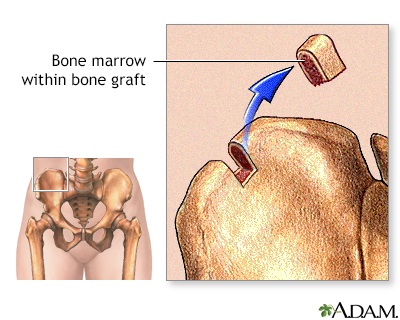Pregnancy SmartSiteTM
Transplant - bone marrow; Stem cell transplant; Hematopoietic stem cell transplant; Reduced intensity nonmyeloablative transplant; Mini transplant; Allogenic bone marrow transplant; Autologous bone marrow transplant; Umbilical cord blood transplant; Aplastic anemia - bone marrow transplant; Leukemia - bone marrow transplant; Lymphoma - bone marrow transplant; Multiple myeloma - bone marrow transplant DefinitionA bone marrow transplant is a procedure to replace damaged or diseased bone marrow with healthy bone marrow stem cells. Bone marrow is the soft, fatty tissue inside your breastbone (sternum) and pelvic bones. Your bone marrow produces blood cells. Stem cells in your bone marrow give rise to all of your different blood cells. DescriptionBefore the transplant, chemotherapy, radiation, or both may be given. This may be done in two ways:
There are four kinds of bone marrow transplants:
A stem cell transplant is usually done after chemotherapy and radiation is complete. The stem cells are delivered into your bloodstream, usually through a tube called a central venous catheter. The process is similar to getting a blood transfusion. The stem cells travel through the blood into the bone marrow. Donor stem cells can be collected in two ways:
Why the Procedure Is PerformedA bone marrow transplant replaces bone marrow that is either not working properly or has been destroyed (ablated) by chemotherapy or radiation. For many cancers, the donor's white blood cells may attack any remaining cancer cells, which are seen as foreign, similar to when white cells attack bacteria or viruses when fighting an infection. Your health care provider may recommend a bone marrow transplant if you have:
RisksA bone marrow transplant may cause the following symptoms:
Possible complications of a bone marrow transplant depend on many things, including:
Complications may include:
Before the ProcedureYour provider will ask about your medical history and do a physical exam. You will have many tests before treatment begins. Before transplant, you will have 1 or 2 tubes, called central venous catheters, inserted into a blood vessel in your neck or arms. This tube allows you to receive treatments, fluids, and sometimes nutrition. It is also used to draw blood. Your provider will likely discuss the emotional stress of having a bone marrow transplant. You may want to meet with a counselor. It is important to talk to your family and children to help them understand what to expect. You will need to make plans to help you prepare for the procedure and handle tasks after your transplant:
After the ProcedureA bone marrow transplant is usually done in a hospital or medical center that specializes in such treatment. Most of the time, you stay in a special bone marrow transplant unit in the center. This is to limit your chance of getting an infection. Depending on the treatment and where it is done, all or part of an autologous or allogeneic transplant may be done as an outpatient. This means you do not have to stay in the hospital overnight. How long you stay in the hospital depends on:
While you are in the hospital:
After you leave the hospital, be sure to follow instructions on how to care for yourself at home. Outlook (Prognosis)How well you do after the transplant depends on:
A bone marrow transplant may completely or partially cure your illness. If the transplant is a success, you can go back to most of your normal activities as soon as you feel well enough. Usually it takes up to 1 year to recover fully, depending on what complications occur. Complications or failure of the bone marrow transplant can lead to death. ReferencesAmerican Cancer Society website. How stem cell and bone marrow transplants are used to treat cancer. www.cancer.org/cancer/managing-cancer/treatment-types/stem-cell-transplant/why-stem-cell-transplants-are-used.html. Revised March 20, 2020. Accessed February 19, 2024. Im A, Pavletic SZ. Hematopoietic stem cell transplantation. In: Niederhuber JE, Armitage JO, Kastan MB, Doroshow JH, Tepper JE, eds. Abeloff's Clinical Oncology. 6th ed. Philadelphia, PA: Elsevier; 2020:chap 28. Zubair AC, Rowley SD. Practical aspects of hematopoietic stem cell harvesting and mobilization. In: Hoffman R, Benz EJ, Silberstein LE, et al, eds. Hematology: Basic Principles and Practice. 8th ed. Philadelphia, PA: Elsevier; 2023:chap 102. | |
| |
Review Date: 2/2/2023 Reviewed By: Mark Levin, MD, Hematologist and Oncologist, Monsey, NY. Review provided by VeriMed Healthcare Network. Internal review and update on 02/20/2024 by David C. Dugdale, MD, Medical Director, Brenda Conaway, Editorial Director, and the A.D.A.M. Editorial team. The information provided herein should not be used during any medical emergency or for the diagnosis or treatment of any medical condition. A licensed medical professional should be consulted for diagnosis and treatment of any and all medical conditions. Links to other sites are provided for information only -- they do not constitute endorsements of those other sites. No warranty of any kind, either expressed or implied, is made as to the accuracy, reliability, timeliness, or correctness of any translations made by a third-party service of the information provided herein into any other language. © 1997- A.D.A.M., a business unit of Ebix, Inc. Any duplication or distribution of the information contained herein is strictly prohibited. | |

 Bone marrow aspira...
Bone marrow aspira... Formed elements of...
Formed elements of... Bone marrow from h...
Bone marrow from h...
